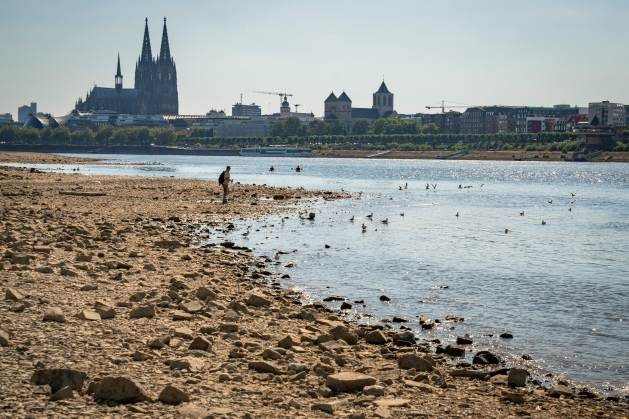Now Europeans Learn What Climate Extremes Are All About
TRANSCEND MEMBERS, 1 May 2023
Baher Kamal | Human Wrongs Watch - TRANSCEND Media Service
25 Apr 2023 –

Rhine River, Cologne, Germany, 2022 – Credit: Shutterstock.
Scientific evidence confirms that, much earlier than that war, Europe, like many other regions, was already walking closer to the edge of extreme weather consequences.
Europe’s worst drought in 500 years?
“The drought episode that affected Europe in 2022 could well be the worst in 500 years,” reports Copernicus, the Earth observation component of the European Union’s Space programme which “looks at our planet and its environment to benefit all European citizens and offers information services.”
This European service further explains that the 2022 drought episode “is attributable to a severe and persistent lack of precipitation, combined with a sequence of repeated heat waves that have affected Europe from May to October.”
Put simply, the reported climate extremes in Europe are not the consequence of the Ukraine war, and they were already there many years earlier to when it started in February 2022.
Anyway, European citizens now hear the devastating impacts of climate extremes in their own rich continent, which is one of the major global contributors to the ongoing climate emergency.
Are climate emergencies just an impoverished regions’ problem?
So far, the severe impacts of climate extremes in Africa and other impoverished regions, would jump to the news every now and then, by showing short videos of errant human beings and deserts… before analysing in-depth the latest soccer games or reporting on the new friend of a reality-show star. And highway accidents or a fight between young gangs.
Western citizens are also used to hearing that the horrifying numbers of hungry people (more than one billion human beings), in particular in East Africa due to long years of record droughts, is either caused by the war in Ukraine or that their situation was exacerbated by it.
Now European citizens wake up to the upsetting fact that they also fall under the heavy impact of the steadily rising human, economic, and environmental toll of climate change.
The most expensive hazards during the period 1980-2021 include the 2021 flooding in Germany and Belgium (almost EUR 50 billion), the 2002 flood in central Europe (over EUR 22 billion), the 2003 drought and heatwave across the EU (around EUR 16 billion), the 1999 storm Lothar in Western Europe and the 2000 flood in France and Italy (both over EUR 13 billion), all at 2021 values.
How come those impacts are now becoming news?
A swift answer is that such climate extremes, heat waves, severe droughts, water and food production shortages have been causing increasing damage to private businesses, as well as to medium-to-small-size agriculture activities. In short, damaging their pockets.
See what the very same European Union officially says at the macro level:
– Weather- and climate-related hazards, such as temperature extremes, heavy precipitation and droughts, pose risks to human health and the environment and can lead to substantial economic losses.
— Between 1980 and 2021, weather- and climate-related extremes amounted to an estimated EUR 560 billion (2021 values).
– Hydrological events (floods) account for over 45% and meteorological events (storms including lightning and hail, together with mass movements) for almost one-third of the total.
– When it comes to climatological events, heat waves are responsible for over 13% of the total losses while the remaining +/-8% are caused by droughts, forest fires and cold waves.
– The most expensive hazards during the period 1980-2021 include the 2021 flooding in Germany and Belgium (almost EUR 50 billion), the 2002 flood in central Europe (over EUR 22 billion), the 2003 drought and heatwave across the EU (around EUR 16 billion), the 1999 storm Lothar in Western Europe and the 2000 flood in France and Italy (both over EUR 13 billion), all at 2021 values.
– A relatively small number of events is responsible for a large proportion of the economic losses: 5% of the weather- and climate-related events with the biggest losses is responsible for 57% of losses and 1% of the events cause 26% of losses (EEA’s own calculations based on the original dataset).
– This results in high variability from year to year and makes it difficult to identify trends. Nevertheless, the average annual (constant prices, 2021 euros) losses were around EUR 9.7 billion in 1981-1990, 11.2 billion in 1991-2000, 13.5 billion in 2001-2010 and 15.3 billion in 2011-2020.
– The Intergovernmental Panel on Climate Change predicts that climate-related extreme events will become more frequent and severe worldwide. This could affect multiple sectors and cause systemic failures across Europe, leading to greater economic losses.
– Only 30% of the total losses were insured, although this varied considerably among countries, from less than 2% in Hungary, Lithuania and Romania to over 75% in Slovenia and the Netherlands.
Also at the medium-to-micro level
Most medium-to-small agricultural cooperatives, unions and associations in those European countries more stricken by droughts, have been rising their public protests, demanding their governments to compensate them for the big losses of their harvests.
In the specific case of Spain, farmers’ unions and agri-food cooperatives report crop losses of up to two-thirds of the expected harvest.
Back to Copernicus
The “historical drought” affected Europe as evidenced by the Combined Drought Indicator of the Copernicus Emergency Management Service European Drought Observatory for the first ten-day period of September 2022.
On this, Copernicus reports the following findings:
– Heatwaves: 2022 was also characterised by intense, and in some areas prolonged, heatwaves which affected Europe and the rest of the world, breaking several surface air temperature records.
– As reported in the July 2022 Climate Bulletin published by the Copernicus Climate Change Service July 2022 was the sixth warmest July in Europe.
– Temperature anomalies reached peaks of +4ºC in Italy, France, and Spain.
According to the European Union’s Copernicus:
– The prolonged drought that has affected various parts of the globe together with the record temperatures were contributing forces that have certainly caused an increased wildfire risk, which peaked during the summer season both in Europe, in the Mediterranean region, and in the north-west of the United States.
– The Combined Drought Indicator (which is published by the European Drought Observatory as part of the Copernicus Emergency Management Service) reported that more than one-fourth of the EU territory was in “Alert” conditions in early September.
– Another extreme phenomenon of 2022 was the marine heatwave that affected the Mediterranean Sea in the summer of 2022.
European countries are highly dependent on the Mediterranean Sea for shipping goods, including oil tankers; tourism (one country – Spain receives more than 80 million tourists a year, double its total population); industrial fishing; refineries; harbours, and a long etcetera.
_____________________________________________
 Baher Kamal, a member of the TRANSCEND Network for Peace Development Environment, is an Egyptian-born, Spanish national, secular journalist, with over 45 years of professional experience — from reporter to special envoy to chief editor of national dailies and an international news agency. Baher is former Senior Advisor to the Director General of the international news agency IPS (Inter Press Service) and he also contributed to prestigious magazines such as TRANSCEND Media Service, GEO, Muy Interesante, and Natura, Spain. He is also publisher and editor of Human Wrongs Watch.
Baher Kamal, a member of the TRANSCEND Network for Peace Development Environment, is an Egyptian-born, Spanish national, secular journalist, with over 45 years of professional experience — from reporter to special envoy to chief editor of national dailies and an international news agency. Baher is former Senior Advisor to the Director General of the international news agency IPS (Inter Press Service) and he also contributed to prestigious magazines such as TRANSCEND Media Service, GEO, Muy Interesante, and Natura, Spain. He is also publisher and editor of Human Wrongs Watch.
Go to Original – human-wrongs-watch.net
Tags: Anglo America, Climate Change, Energy, European Union, Global warming, NATO, Nordstream 2, Pentagon, Proxy War, Russia, Science, USA, Ukraine
DISCLAIMER: The statements, views and opinions expressed in pieces republished here are solely those of the authors and do not necessarily represent those of TMS. In accordance with title 17 U.S.C. section 107, this material is distributed without profit to those who have expressed a prior interest in receiving the included information for research and educational purposes. TMS has no affiliation whatsoever with the originator of this article nor is TMS endorsed or sponsored by the originator. “GO TO ORIGINAL” links are provided as a convenience to our readers and allow for verification of authenticity. However, as originating pages are often updated by their originating host sites, the versions posted may not match the versions our readers view when clicking the “GO TO ORIGINAL” links. This site contains copyrighted material the use of which has not always been specifically authorized by the copyright owner. We are making such material available in our efforts to advance understanding of environmental, political, human rights, economic, democracy, scientific, and social justice issues, etc. We believe this constitutes a ‘fair use’ of any such copyrighted material as provided for in section 107 of the US Copyright Law. In accordance with Title 17 U.S.C. Section 107, the material on this site is distributed without profit to those who have expressed a prior interest in receiving the included information for research and educational purposes. For more information go to: http://www.law.cornell.edu/uscode/17/107.shtml. If you wish to use copyrighted material from this site for purposes of your own that go beyond ‘fair use’, you must obtain permission from the copyright owner.